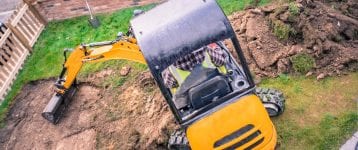Excavations are a delicate process. Failure to comply with the Environmental Protection Agency’s guidelines can cause lasting harm to the public, the environment, and your business’s bottom line.
There’s much more to a successful excavation than digging a hole and filling it well. Factors like stormwater, pollutants, power conduits, and public safety all come into play.
Every New Jersey excavation needs to be environmentally responsible. Nature is a delicate ecosystem, and even the slightest alteration to the landscape can cause a knock-on effect of damage. The Environmental Protection Agency (EPA) set the Construction and Development Effluent Guidelines and Standards in 2009 to monitor best practices on excavation sites. Here’s what you need to know about those rules and if your excavation makes the grade.
Minimizing soil erosion
Soil erosion is the degradation or complete removal of the top layer of soil. This top layer plays a crucial role in maintaining any ecosystem. If it’s compromised, the land becomes far more vulnerable to pollutants, as do waterways. Excavations always involve topsoil displacement, but the EPA rules mandate that only the project area be affected and not the surrounding land.
A lack of quality topsoil also increases the risk of flooding, and that’s a problem New Jersey already struggles with. Federal codes require that every project implement erosion and sediment controls to limit the velocity and volume of stormwater discharged during a dig.
Stormwater moving in mass and at speed hits topsoil hard, stripping it back (termed “scouring”) or removing it entirely. Special attention must be paid to sloping land, as disturbing soil on a slope can displace a lot of earth. This exposes vulnerable layers of deep soil to erosion and pollution.
Stabilizing displaced soil
Soil disturbed during digs must be stabilized immediately, regardless of whether the construction team has left permanently or only temporarily. There may be site-specific exceptions depending on the project that can require soil to remain disturbed, but these are exceptions.
Soil stabilization is important because wet, unstable soil is a safety hazard to both the excavation team and anyone else in the area. Soil is stabilized by adding either primary or secondary binders, such as cement, ash, or lime. These cause a reaction with the moisture already in the soil to create a binding agent that helps prevent a landslide.
Pollutant control
Factors like oil leaks and spills are common during construction work, but they pose added risk during excavations that expose delicate undersoil. Even soaps and solvents used to clean vehicles are viewed seriously by the EPA because runoff can negatively impact soil, plant growth, and animal life.
Fuels and other potential hazards like construction waste, general human trash, and water from washed concrete (which may have been treated with preservative chemicals) can add up to a significant environmental threat as well.
Particulate matter (PM) is a nearly invisible pollution threat at excavation sites. These tiny particles can cause great damage to human health and the environment, and excavation sites can account for up to 70 percent of harmful PM in urban areas.
PM includes acids, organic chemicals, and man-made compounds from fuels, metals, soil, and dust particles that can irritate the eyes and skin. At its worst, inhaled PM can injure the lungs and heart. Every excavation site must minimize or remove these pollution risks by implementing chemical spill and leak prevention and response procedures.
Protective measures and the cost of non-compliance
Applying the EPA’s Best Management Practices (BMPs) helps excavation sites contain the risks of soil erosion, displacement, and pollution. Some or all of these may be required depending on the size of a dig.
Failure to comply with the EPA’s guidelines has serious consequences. The Clean Air Act exists to prevent issues like particulate matter and exhaust fumes, and the EPA closely monitors runoff. These measures pay added attention to the pollution potential of underground storage tanks, which are a classic problem for many New Jersey excavations.
The EPA won’t hesitate to apply criminal enforcement to any excavation site suspected of carelessly endangering the community or environment, with penalties including years in prison and steep fines. EPA figures are currently:
- For negligent violations: 1 year and/or $2,500 – 25,000 per day. Subsequent convictions 2 years and/or $50,000 per day.
- For knowing violations: 3 years and/or $5,000 – 50,000 per day. Subsequent convictions 6 years and/or $100,000 per day.
Hiring anything less than a seasoned professional firm is a bad move for you, your community, and the environment. The Mikula team will protect your personal interests and do an EPA-approved job.
Let Mikula handle your next dig
Excavation teams face many risks, and the Occupational Health and Safety Administration (OSHA) enforces strict standards for worker safety. Mikula Contracting offers the perfect combination of EPA qualifications and OSHA standards combined with over 70 years of excavation experience. Get in touch to make sure your excavation obeys the law and keeps everyone as safe as possible.
Mikula Contracting, Inc. provides commercial and residential customers with a wide range of excavation, demolition, environmental, snow removal, trucking, and soil materials services. For more information, call 973-772-1684 or email info@mikulainc.com



